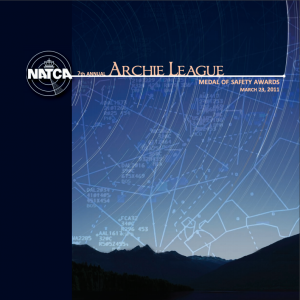
2011 – Winners of the 7th Annual Archie League Medal of Safety Awards, honored on March 23, 2011 at the Rio in Las Vegas:
Alaskan Region: David Whisnant, Anchorage TRACON
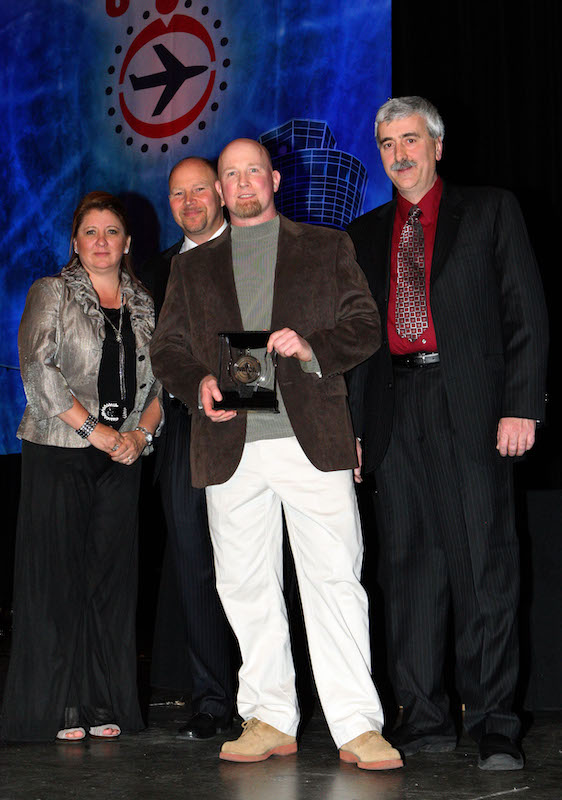
Douglas Mruk phoned in for help on the early morning of June 30, and it was not from the sky, or even solid ground. Mruk found himself clinging to the edge of his overturned boat in the frigid waters of Cook Inlet, Alaska, as he reported his emergency via cell phone to Anchorage Fire Department dispatch.
Luckily for this distressed boater, certified professional controller David Whisnant was on duty that day at Anchorage TRACON (A11), and immediately took action to assist the search and rescue efforts. Whisnant coordinated with a military Sherpa aircraft in the boater’s vicinity of Birchwood to look for the overturned boat, and sure enough, the aircraft soon spotted a person in the water with a life preserver. Volunteering to remain in the area, the Sherpa circled the site as it waited for rescue personnel to arrive.
While Whisnant efficiently worked to receive the exact coordinates of the aircraft (and therefore the boat in distress), a VFR helicopter came over frequency amid a busy stream of transmissions, reporting his location in the Birchwood area.
Thinking fast, Whisnant asked if the aircraft was able to make a water rescue, and after quick confirmation, transferred the Sherpa’s GPS location of the boat to the helicopter. Minutes later, the boater was being picked up out of the water.
BOXCAR64: Approach, Boxcar six-four, looks like the helicopter got that guy out of the inlet…
APPROACH: Helicopter gulf uniform yankee, Anchorage Approach, understand you’ve picked up the, uh, person out of the water?
CGUY: Yes sir, I did. He is really cold. How about if I drop him off at the hospital downtown?
Trapped in waters of less than 40 degrees, Mruk was reported to be hypothermic upon retrieval. Without Whisnant’s responsive actions, the worst would have happened, as Whisnant was later informed that the injured boater would not have lasted another 10 minutes due to the temperatures he encountered that morning.
As we typically witness in this profession, it is not always the ordinary “aircraft in distress” occurrences that we come across each day, but frequently the unexpected that require our safety professionals to stay at the top of their game. Whisnant demonstrated this to a tee, and due to his proactive assistance through a unique circumstance, an individual’s life was saved.
Larry Lescanec, Alaskan Regional Vice President:
“It is because of A11 controller David Whisnant’s quick reaction and practical application of his experience, that a boater who had capsized in Alaska’s icy waters is still alive today. Dave immediately took control upon retrieving news of the situation, and utilized a military aircraft and a general aviation helicopter that happened to be in the area to orchestrate the rescue of the stranded boater. This event is proof that the air traffic profession is not just about the typical rescue among the skies, but rather staying on the tips of your toes in preparation for every unexpected circumstance that comes your way. Dave did just this on June 30, 2010, and responded to such with skilled and professional assistance to all persons involved.”
Central Region: David Cornell, Cedar Rapids ATCT
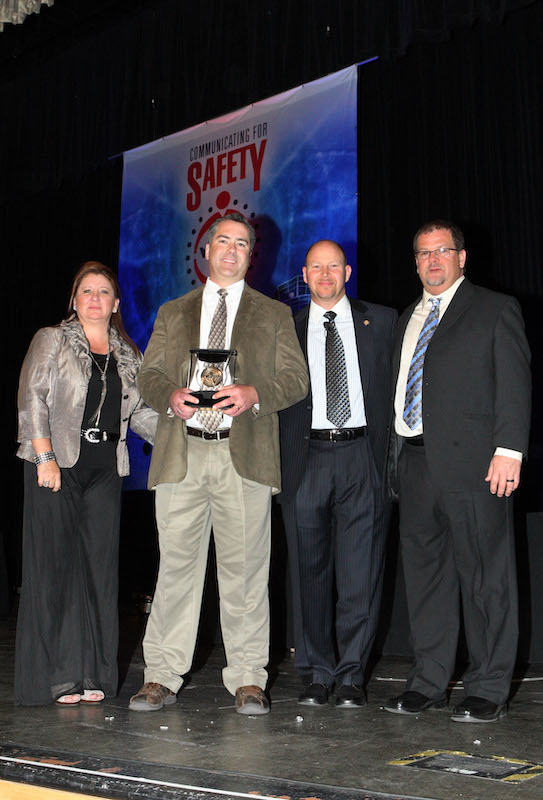
On the evening of Jan. 18, 2010, 17-year veteran controller David Cornell received the call many controllers dread. Cessna N8584X was declaring an emergency.
In an area suffering from low ceilings and visibility, this aircraft was currently stuck on top of the clouds with only 30 minutes of fuel remaining, and it needed to land. Cornell radar-identified the Cessna and asked all the correct questions in order to gather as much information as he could on the situation. After checking with other facilities in regards to weather in other areas, as well as Flight Service, it became clear that there were just no options within the range of this aircraft.
Cornell decided that his only choice was to try to get this pilot to the Cedar Rapids Airport (CID). Learning that the pilot did not have any approach plates for CID, Cornell began giving instructions on how to set up the aircraft for the ILS approach. An IFR-pilot himself, Cornell would have to talk this VFR-pilot all the way down. Contacting the airport safety office to put the airport on alert status, he then called a front line manager at home to inform him of the situation, knowing that they were now out of alternatives – the pilot’s aircraft was coming down somewhere in 25 minutes.
While relaying instructions to the pilot, with an intent focus to keep him above the top of the clouds as to not get disoriented, Cornell even took the time to ask pilot Doug Tindal his name so as to further calm him during the remainder of the stressful situation. Given the reporting ceilings, the only approach available to get the aircraft below the bases of the clouds was an ILS – an approach that Mr. Tindal had never attempted before, and now only had one shot at making. In essence, Cornell was working the aircraft on a modified Airport Surveillance Approach, one that is not published or con-ducted at CID, combined into an ILS approach. Making sure the aircraft didn’t descend too early or spend too much time in IMC during descent, Cornell carefully instructed the pilot towards the airport until lights were reported about one and a half miles from the runway.
Cornell received indication that the plane was now only 100 feet above the ground due to its rapid de-scent rate, and he quickly reacted with a low altitude alert. After receiving no response, and simultaneously losing the aircraft on radar, airport rescue vehicles were dispatched. Cornell later learned that the aircraft, first come across by a passing snowmobiler, had crash-landed in a field about a mile short of the runway. Remarkably, the pilot walked away with only a broken arm after an event that could have so easily ended with the worst.
“This incident is a textbook example of what personifies us as air traffic controllers,” shared 23-year veteran Jerry Reichenbach, CID facility representative and the on-duty CIC assisting that day. “Dave remained calm and cool during the event, knowing full well that he might very well be the last person on earth to talk to this man… but I knew good and well that if anyone at the tower that day could get Mr. Tindal on the ground safely, it was Dave.”
Kevin Peterson, Central Regional Vice President:
“On Sunday, Jan. 18, 2010, weather at the Eastern Iowa Airport in Cedar Rapids, Iowa, was below landing minimums for most aircraft. The ceiling was 100 feet with freezing fog and half-mile visibility, in a widespread area covering all mid-western states. Dave Cornell, 17-year air traffic control veteran, was working radar when he received that dreaded call from N8584X, and is the primary reason this pilot is alive today. Dave’s calmness and attention to duty exemplifies who we are as air traffic controllers. Dave remained calm throughout this event while knowing full well he might be the last person this pilot talked to. Dave’s actions on this foggy night at the Cedar Rapids Airport were nothing but outstanding.”
Eastern Region: Mike Chambers and Clint Clifton, Huntington ATCT


“I have replayed our communications in my mind a hundred times,” stated pilot Bob Taylor in a recent letter.
It was the evening of Oct. 12, 2010, when his worst fears turned reality. Having been handed off from Indianapolis Center (ZID) upon his return trip to Greensboro, N.C., from Limo, Ohio, Mr. Taylor checked in at 7,500 feet. “I have a serious problem,” relayed Taylor instantly. His engine was sluggish, the controls were vibrating, and he was unable to maintain altitude.
Lucky for this pilot, he was greeted on the other end by 23-year veteran Mike Chambers and trainee Clint Clifton of Huntington Tower (HTS). Immediately declaring an emergency for the distressed Piper Cherokee, these two controllers informed Taylor of two nearby airports, the closest of which was James Rhodes Airport. After informing the radar controller in charge to notify local law enforcement of the situation, Chambers and Clifton immediately began relaying important information to the pilot, including runway configuration, length field elevation and local frequencies.
After hearing a fearful Mr. Taylor declare he was “not going to make it,” Clifton ensured him that they were going to do everything they could do to get him down safely. While Clifton emphasized on providing reassurance, Chambers kept up with constant instructive readouts. The two continued with position reports and course guidance in order to calm the pilot and instill confidence in his abilities until, about 20 miles later, they were able to point out the airport. Now picking up the airport visually, the pilot was finally convinced he would make the airport and switched over to the advisory frequency for the uncontrolled field. Soon after, the facility learned that the aircraft had, in fact, landed safely. A few days later the pilot even called the facility to thank Clifton, in addition to sending a box of cigars around Christmas – a gift that Mr. Taylor admitted his heroes will likely be receiving for many Christmases to come.
“I commend your professional handling of the situation. Moreover, how you handled me. I was just plain scared,” shared Taylor in the letter of appreciation to those responsible for his rescue that day. “Your calming, professional voices gave me the hope that if I ‘Aviated, Navigated and Communicated’ I’d make it… Together we made the 20-mile journey.”
Each controller exhibited certain qualities, and contributed specific necessary actions to this situation, that together brought about a successful outcome. At the end of the day, it was the teamwork of these two individuals – one with over two decades of experience, and the other on the brink of his career – that produced this save embodied by an array of skill and an extraordinary level of care.
Phil Barbarello, Eastern Regional Vice President:
“Above anything else on Oct. 12, Mike and Clint were determined to stay with this pilot every second of the way. With Bob Taylor struggling to maintain altitude, leaving nothing but hills and trees in the immediate surroundings of his Piper Cherokee, the odds at stake were definitely not great. Nonetheless, the slim chances were not going to stop these two controllers from doing everything they possibly could to beat the odds. And this they did, staying by Bob’s side through his 20 miles of panic until a safe outcome was within reach at Tri-State Airport. Reassurance is everything to some pilots, and when followed up with expert instructions, delivers a recipe for success that Mike and Clint are happy to have supplied.”
Great Lakes Region: Gregory Dukeman, Cleveland Center
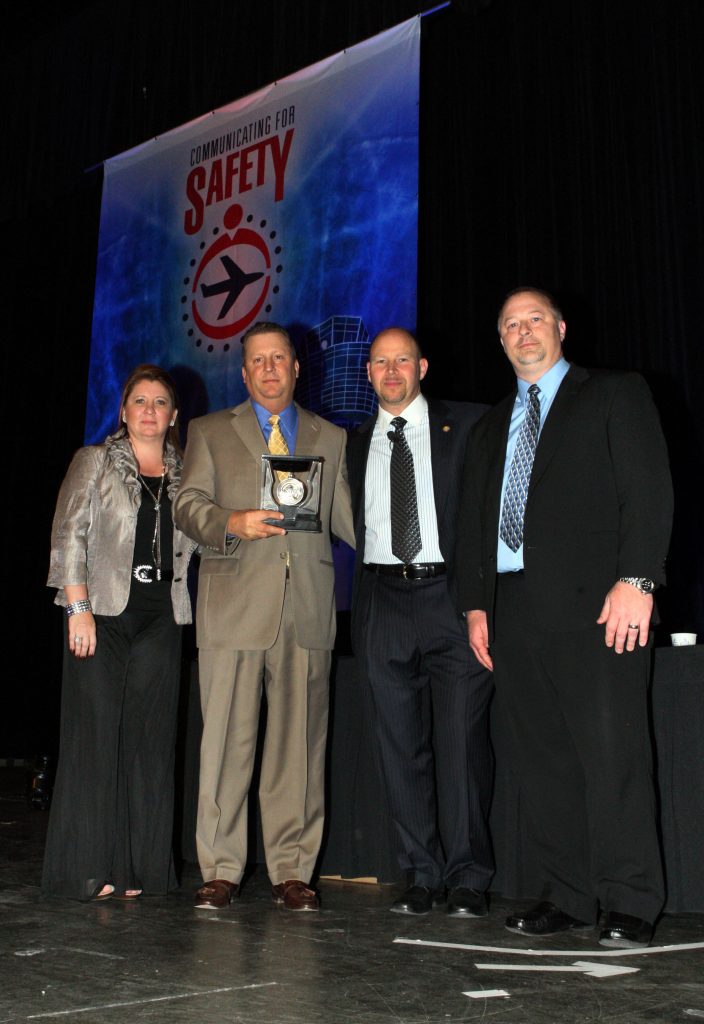
With an excess of admirable patience and dedication, a Cleveland Center (ZOB) member took control of a tricky situation last year. The episode that occurred on June 24, 2010, was a complicated one, and controller Gregory Dukeman definitely had his hands full.
On this particular day, Dukeman was faced with a disoriented VFR-only pilot that was unable to maintain minimum altitude while entering areas of IFR conditions. On top of this, the pilot spoke with an accent, which at times made communications between the two difficult.
N242AV: We are now with IMC situation. Can you advise us to, uh, landing for nearby airport?
Dukeman: You say you want to land at the nearest airport?
N242AV: Yes sir.
Dukeman, determining the closest airport to be Bradford, Penn., provided advisories to N242AV, as well as suggested headings and altitudes. All the while, he assisted other aircraft on frequency that included one simultaneously experiencing weather issues towards Buffalo.
Turning his focus to the disoriented pilot of N242AV, now frequently moving in and out of radar contact, Dukeman set in to get this aircraft on the ground. At one point, the aircraft was picked up on radar 180 degrees off course among the IMC conditions, and Dukeman took this opportunity to suggest another airport. However, the pilot was persistent in continuing on towards Bradford, and Dukeman was determined to do everything he could to get him there safely.
N242AV: How high to the, this cloud is at?
Dukeman: Are you asking how high the clouds are in that area?
N242AV: Yes sir, I want to know.
Dukeman: I show a broken layer at, uh, Bradford, two thousand feet.
Dukeman concentrated on keeping this pilot out of the worst of the weather, while continuing with instructions towards his intended destination. Providing additional, above and beyond assistance, he made certain that the pilot not only knew how to use the UNICOM frequency to turn on the lights at the airport, but also the phone number to call and report when he was safely on the ground, despite the numerous communication difficulties that ensued in getting this message across. Finally, about 45 minutes after the start of this increasingly dangerous situation, the pilot reported the field in sight. After providing field elevation for landing, Dukeman noticed that the pilot had once again mistakenly reversed course, which caused him to momentarily lose sight of the airport. The pilot, after being repositioned for the airport a second time, was switched over to the UNICOM frequency for an attempt at a VFR approach.
During the full extent of this time-consuming event, Dukeman made sure to offer up alternative landing options, as well as ensure that the pilot in crisis had all the information needed to ensure the best outcome possible. Not all people can take such a variety of difficult circumstances and react with such commitment and poise. There is no telling what would have happened without Dukeman’s professional assistance, which all paid off when a breathless and noticeably appreciative pilot was heard on the other end of the phone shortly thereafter. Calling up the center after a successful landing, the pilot confirmed what many in the room that day were already sure of – the controller’s actions had saved this pilot’s life. After repeated thanks, the pilot said goodbye, truly sounding like a man who was grateful to be alive.
Bryan Zilonis, Great Lakes Regional Vice President
“Working on a day when weather impacts your airspace is always a unique challenge. And, when a VFR pilot receiving flight following enters IFR conditions, it can become especially dangerous. For the pilot of N242AV, that is exactly what occurred on June 24, 2010. Routine flight following became nearly an hour of suggested vectors around weather and towards the nearest airport. The aircraft on several occasions reversed course unexpectedly, and despite it going in and out of radar contact, our regional Archie League winner, Gregory Dukeman, was able to assist this pilot in finding the Bradford Airport where he then landed safely. Shortly after, the watch desk at Cleveland Center received a call from the breathless pilot who stated, ‘You saved my life.’ These actions demonstrate the crucial role our controllers play each and every day in protecting the lives of our nation’s aviators, and I join my fellow controllers in the Great Lakes Region in thanking Gregory for his exceptional commitment to safety.”
New England Region: Chuck LaBombard, Burlington ATCT
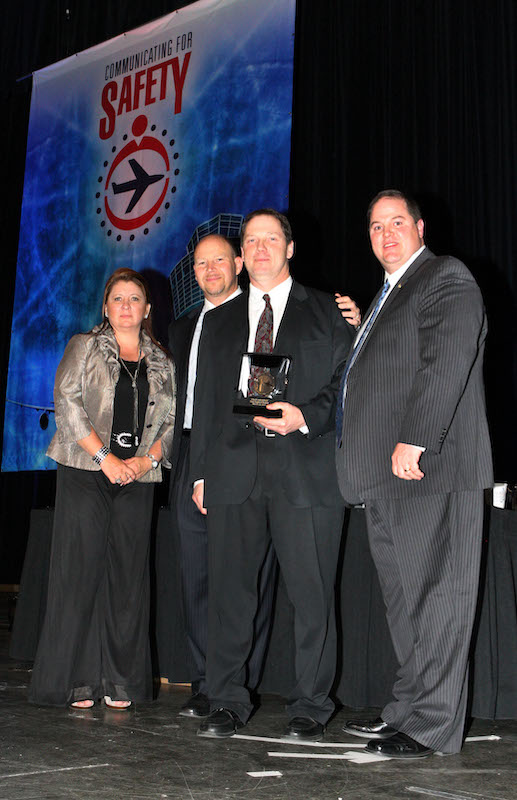
Twenty-five-year veteran Chuck LaBombard took his position relief briefing at Burlington on Sept. 26, 2010, expecting to take over a somewhat tricky, but overall fairly normal operation. However, it didn’t take long for him to realize that the situation he was taking over would be anything but ordinary.
Moments earlier, the pilot of N634K had panicked on the GPS Runway 33 approach, reversing course into a JetBlue aircraft on final. Now, taking on her next attempt, the pilot announced she was low on fuel. Becoming distressed and disoriented, she declared moments later that she was unable to make the approach.
“Low altitude alert, climb immediately ma’am,” voiced LaBombard to the aircraft, which had now descended to 1,100 feet below minimum altitude. “Climb immediately and maintain five thousand four hundred.” Working to keep the aircraft wings level and the aircraft climbing, LaBombard coached the pilot with encouraging words as he contemplated his next plan of attack.
When asked about a VOR approach, the pilot admitted she would be unable to fly it due to nerves. The pilot’s choices were narrowing and recommendations of different airports and approaches proved unsuccessful with the now-panicking pilot.
LaBombard: Columbia three-four kilo, what would you think about doing an ILS approach to the Plattsburgh International Airport, that’s about ten northwest of Burlington?
N634K: I don’t know if I can make it, I mean I am out of fuel.
LaBombard: Columbia three-four kilo, we’re gonna vector you right over the runway.
Applying older procedures he had not practiced in years, LaBombard performed his last resort – an ASR approach from memory. With strict ending instructions to pick “any runway and land,” the aircraft finally came to a successful stop at Burlington minutes later, with just three gallons of fuel remaining.
LaBombard was faced that day with what had become a life and death situation, left not only with limited options but a frazzled pilot to keep calm, as well. Despite these difficult circumstances, he was able to produce a safe and successful outcome thanks to the high level of experience and skill he brings to the job. It is the cool and composed performance such as this one that distinguishes our workforce from so many others, and ultimately ensures we remain the safety aviation system in the world.
Mike Robicheau, New England Regional Vice President
“The story we have here is a great one. A seasoned controller identifies that a pilot is in trouble, and without hesitation, jumps on to the radar position, calms the pilot, and lands her successfully. During this ordeal, it quickly became evident to Chuck that everyday practices weren’t going to get this aircraft on the ground. He used his experience to consider the best options available for this increasingly dangerous situation, ultimately determining that he would have to recall older procedures he had not used in years if this aircraft was ever going to make it to the ground safely. This is only one example of the pride and professional attitude Chuck brings to work day in and day out, and we are proud of the prominent role he plays in ensuring the NAS remains a safe place to fly.”
Northwest Mountain Region: Dean Miller, Denver Center
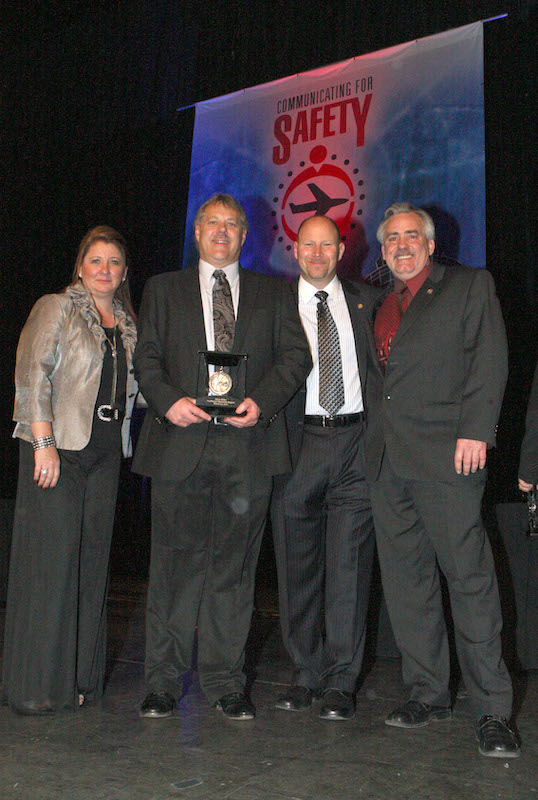
It’s true what they say about Northwest Mountain controllers: they are definitely no strangers to working aircraft in high terrain – with usually some icing and wintery weather thrown in.
These were the conditions Denver Center (ZDV) controller Dean Miller faced on Oct. 18, 2010, when an aircraft came on frequency declaring an instant three-degree temperature drop. While traveling northbound towards Centennial Airport, in an area of 120 minimum IFR altitude near Raton, N.M., N787CB encountered heavy icing upon entering a cloud layer. It needed to get lower, and needed it fast.
Miller: November seven charlie bravo, I’ll get you lower as soon as I can. Right now that’s my minimum IFR altitude. If we need to declare an emergency let me know.
N787CB: Seven charlie bravo emergency, descend immediately.
While simultaneously making sure the aircraft stayed at an altitude as high as possible, this 20-year NATCA member began working it east away from mountainous terrain. While Miller took control of the now-emergency situation over frequency, he requested a D-side to call Albuquerque Center (ZAB) for information on their lowest IFR altitudes, as the vector east had put the aircraft back into ZAB airspace. While assigning lower altitudes, Miller further assisted the aircraft in researching the VFR chart for the minimum safe altitude/obstruction clearance for the immediate area.
At one point, the pilot turned a 150 heading on his own to try to get out of weather, which would ultimately take longer to reach lower terrain. Miller quickly readjusted by informing the aircraft of new headings, towards better weather at Raton Airport and out of higher terrain at a quicker rate. To make matters worse, the aircraft was now lost on frequency due to its low altitude, and Miller was forced to relay additional clearances through a nearby aircraft. Finally, the distressed aircraft exited the bad weather into clearer VFR conditions and was able to return to his original course.
When all was said and done, and the pilot had safely landed, he contacted the operations manager by phone. He disclosed that it was Dean Miller’s calm voice and demeanor that was to thank for soothing he and his wife’s nerves during the sticky situation – traits, combined with Miller’s quick and efficient skills, which were surely responsible that day in getting this aircraft to the ground in one piece.
Jim Ullmann, Northwest Mountain Regional Vice President
“As most of the controllers working at Northwest Mountain facilities will attest, it is not a matter of ‘if’ you will be involved in a situation involving adverse weather; it is a matter of ‘when.’ Our region has a mix of terrain and wintry weather that has an effect on air traffic during at least six months of the year. Dean Miller and his fellow controllers again proved that, when dealing with aircraft in distress, we work as a team to help ensure a positive outcome. As a longtime controller at more than one facility within the Northwest Mountain Region, Dean Miller is well aware of the possibility that weather may be a factor every time he assumes an operational position. With the recent influx of newer controllers at air traffic facilities all across the NAS, and specifically within our mountainous region, we will have more and more controllers who will ultimately experience a situation similar to this event. It is nice to know that in today’s operational environment, there is blending of the exuberance of youth and wisdom of maturity.”
Southern Region: Derek Bittman, Atlanta Center
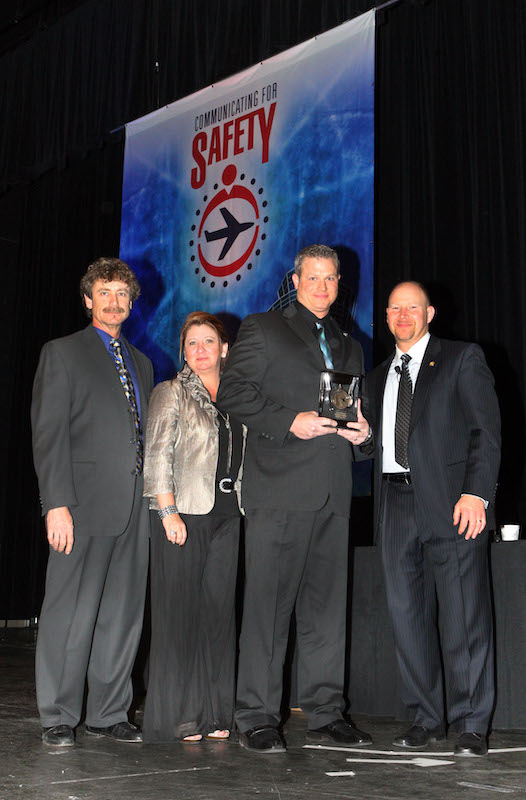
On Jan. 16, 2010, certified professional controller Derek Bittman stumbled across a particular situation that could have easily changed forever the life he had come to know so well.
Bittman was working the Dallas sector at Atlanta Center that day, the busiest and most complex sector in the world, when he was handed over a pilot with navigation equipment mal- functions. This pilot, planning to end his trip in the Atlanta terminal area, had already missed two approaches at the destination due to low ceilings and fog, and furthermore, was low on fuel. After discussing various choices, the pilot opted to proceed to Rome (RMG) for a last attempt, a fairly busy general aviation airport 60 miles northwest of Atlanta.
Bittman: If you can’t make this approach at Rome do you want to go, try and go somewhere else? Do you have a plan B?
N3011N: This was plan B, one-one november.
Confirming Bittman’s fears, the pilot declared a few minutes later that he was still not able to find the airport. With rapidly diminishing options and only 45 minutes of fuel remaining, N3011N was now in a very desperate situation.
After advising that his only offer for the aircraft at this point would be another attempt of the ILS into RMG, Bittman learned that the pilot was not only having trouble with his glide slope on the VOR but his lateral CDI, as well. In receiving this information, Bittman declared an emergency on behalf of the pilot. Providing vectors back to the RMG VOR, he informed the pilot of the area’s numerous highways should the escalating situation resort to immediate landing.
With the VOR the pilot was using to find the airport now malfunctioning, Bittman was forced to use his last resort. Having already split off the sector in order to provide sole attention to the aircraft, he began application of his knowledge from past Marine Corps experience to help this pilot find the airport. He provided precision vectors, similar to an ASR approach, to the aircraft while using the approach plate to give vertical guidance – a tactic not commonly used by the enroute center due to its unreliable radar data and the absence of minimum vectoring altitudes.
Bittman: November one-one november, uh, make sure you understand sir, the calls that I’m giving you are suggestive in nature sir. I do not have a glide slope or a localizer depicted on the scope.
Bittman: Increase the rate of descent… appears you’re left of course and going farther left. Turn five degrees right.
Bittman: November one-one november, radar contact lost, two and a half miles south of the Rome Airport. Last track I had on you had you on course into Rome Airport.
Due to the quick actions by this educated controller, the pilot was able to make visual contact with the runway right before the touchdown point. As it happens, he ran out of gas while taxiing to the ramp, confirming the fact that Bittman’s efforts saved his life.
Bittman used his experience and his skill to help this pilot in his efforts to reach the ground, remarkable qualities both honorable and extraordinary. Bittman made a truly committed controller’s decision – the decision to do whatever it took to save a life.
Southwest Region: Sagar Patel and Robert Nelson, Houston Center
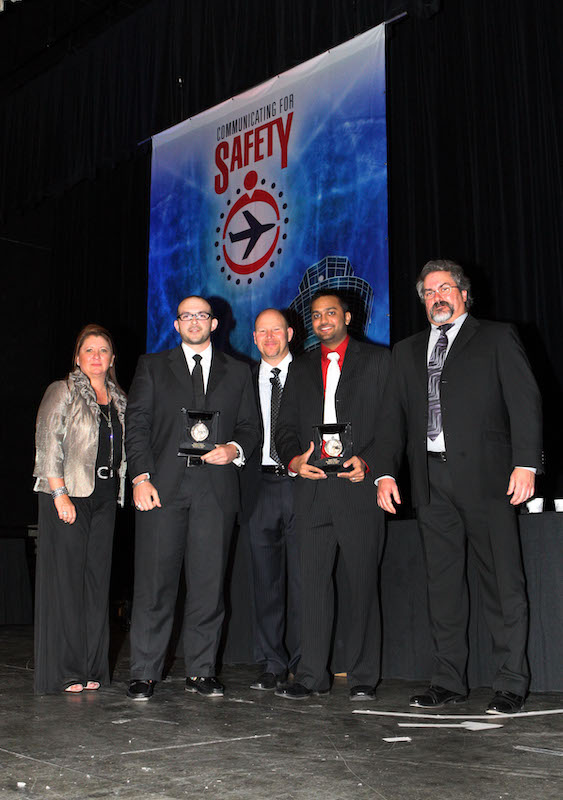
The transmission from the P46 last Dec. 4 was like a shot from the starter’s pistol to begin a race, and it brought Houston Center (ZHU) member Sagar Patel immediately and fully engaged, with time of the essence.
“We’re declaring an emergency, we’re losing power.”
But this was not a typical emergency situation. Below the P46 was the vast Gulf of Mexico. Patel and his fellow NATCA member working the D-side, Robert Nelson, knew they had to work quickly and effectively to accurately plot the aircraft’s location and prepare for the inevitability of the plane descending beneath the range of radar, losing radio communications, and then crash landing in the water. A quick rescue would be essential for survival of the four passengers.
Patel: Descend and maintain flight level one-eight-zero, keep me informed of your descent, let me know how the problem goes.
N350MM: Okay, copy that, uh, we’re gonna arrest our descent at this point, uh, power is up about fifty percent, don’t know what the problem is yet but, uh, we’re losing speed and power but it seems to be stabilizing at the current speed so I want to maintain my altitude unless I have to descend.
Patel then went through a list of questions to get as much information from the pilot as possible; fuel remaining, number of people on board, present position in coordinates, even the color of the aircraft and its flotation devices.
Patel calmly informed the pilot that help was on the way. Meanwhile, Nelson was coordinating all information to the supervisors and informing surrounding sectors to keep aircraft off of the ocean frequency to alleviate congestion. Patel could then devote his full attention to the P46.
The aircraft then spotted an oil rig at its two o’clock position, about 20 miles away, and decided to head for it. Patel asked again for the aircraft’s coordinates but then lost radio communications. Plan B was to solicit help from nearby aircraft. An American Airlines jet was able to reach the pilot first, followed by a Delta flight that informed Patel it was picking up an “extremely strong” ELT signal.
Patel asked the Delta flight to descent and see if it could locate the aircraft visually. After being given a clearance direct to the coordinates, the Delta pilot was able to see what appeared to be an aircraft fuselage in the water, approximately a half mile from the oil rig.
Patel: Houston Center, roger, appreciate your help a lot. We got a Coast Guard going out to there now to the coordinates you gave us of the object and, uh, appreciate your help.
Forty minutes after communication with the downed aircraft was lost, Patel was informed that the four passengers had been rescued from personnel working on the oil rig. The Coast Guard was able to pick up the passengers and bring them in for medical assistance.
Tim Smith, Southwest Regional Vice President:
“In listening to the audio from this event, I was extremely proud of the calm professionalism displayed by these two controllers on Dec. 4, 2010. Sagar Patel and Robert Nelson collectively gathered all of the info they could in regards to the situation and utilized all resources available to them, including other aircraft in the area. In doing so, they were able to not only track down this stranded plane but also ensure that the Coast Guard responded in a timely rescue effort. It was an exemplary display of teamwork by all involved. On behalf of our region and the entire union family, I congratulate them on a job well done!”
Western Pacific Region: Quentin Baca, Southern California TRACON
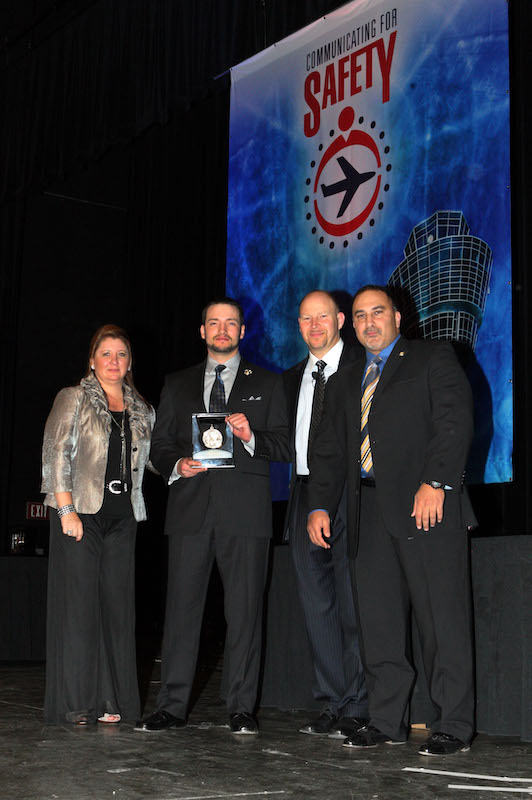
“On behalf of all the aviators in this country, I thank you. People like you, and your peers, are the few groups of unsung heroes of day to day life.”
The appreciative words above are those of flight instructor Michael Esdicul, expressing his gratitude for a man whom at the time he was unable to name. We, however, feel beyond fortunate in being able to call him one of our own. It was Southern California TRACON (SCT) controller Quentin Baca that became this hero for three on Nov. 21, 2010, when he saved the life of Mr. Esdicul and his two students en route to KMYF.
Baca was providing on-the-job training that day when he came across a fellow sector having issues with a possibly lost aircraft – one not under radar contact at the time because of its low altitude. Knowing that something was not quite right with the situation, Baca took initiative and switched the distressed aircraft, N297PA, to his own frequency for guidance.
As it turned out, as learned through continued conversation with the pilot, the aircraft had experienced a rapid downdraft over the mountains east of San Diego, an area that will sometimes experience these due to storm fronts moving through the airspace. The aircraft was now well below the Minimum Vectoring Altitude (MVA) and heading towards higher terrain. Baca’s first thought was to get N297PA south of the terrain that was creating the downdraft so that it could climb easier. Once he redirected the aircraft south of the peak, it was then able to climb to an altitude that allowed him to meet the MVA requirements.
“It was due to his dedication, knowledge, and quick decision-making that we were able to get out of what could have been a fatal situation,” wrote Mr. Esdicul in a recent letter to SCT. “It’s great to know that there are people like him keeping our skies safe and being helpful to us aviators.”
In fact, as revealed by attained flight charts of the event, the aircraft would have likely collided with the mountains that day if not for Baca’s quick assessment to turn it south. Baca followed his instinct from the start of this troubling situation to the very end, and he took proactive steps to initiate necessary actions — actions that if gone untaken would have left us with not only a lost aircraft, but also the loss of all lives on board.
“You might have showed up to work that day thinking that it’s going to be just like any other day,” Esdicul continued. “Now, you know that your presence that day made all the difference. It saved three lives. Lives that can now continue to enjoy living.”
Hamid Ghaffari, Western Pacific Regional Vice President:
“The difference between a good air traffic controller and a great air traffic controller is the ability to have the situational awareness of, not only the aircraft under your responsibility, but the peers who work around you. Teamwork, pride, and professionalism are what Quentin Baca displayed on the morning of Nov. 21, 2010. Quentin was responsible for providing on-the-job instruction to his developmental controller at the Del Mar sector in San Diego. As soon as Quentin realized that a fellow controller was having difficulties with an aircraft that appeared lost, he sprung into action and displayed tremendous situational awareness and professionalism, in not only finding this aircraft but also in taking the appropriate steps to guide it away from hazardous terrain. I am extremely proud of Quentin for his exemplary professionalism, performance, and teamwork.”
Region X: Mark Anderson, Aircraft Certification
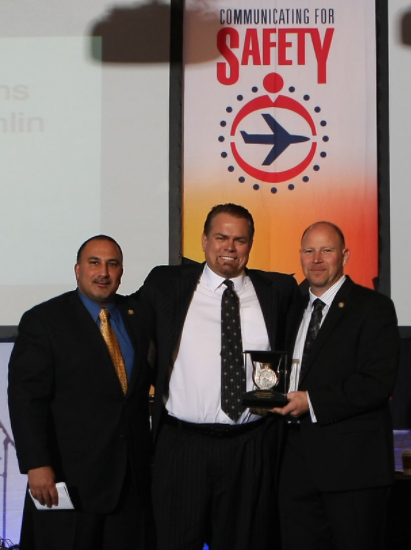
NATCA member Mark Anderson has been a test pilot for 25 years, working for the FAA for 20. So, when asked several years ago if he’d be interested in helping out with the Boeing 787 certification program, this Aircraft Certification member of Region X, of course, said yes.
So far, Anderson has acted as a 787 guest test pilot for about five or six flights, but on Nov. 9, 2010, he came across his biggest test yet.
Things started going poorly at about at 1,000 feet above the ground as Anderson came up on the end stretch of his six and a half-hour test flight. He was flying the airplane manually through the head-up display when the display suddenly went dark. Moments later, the auto-brake clicked, and the first call declaring smoke in the cabin followed. Then, with the call of fire at 500 feet, about 30 or so Engine Indicating and Crew Alerting System (EICAS) warning, caution, and advisory messages started rapidly displaying. All four engine-driven generators dropped off the line and attempts to start the auxiliary power unit failed. “At best,” Anderson recalled, “we thought we had partial electrical power, but maybe as little as an aircraft battery and the ram air turbine, which provides emergency back-up electrical power.”
Anytime you have a smoke or fire event in an airplane such as this, it is known across the industry that rule one is to get on the ground as quickly and safely as you can. And this is exactly what Anderson did. With smoke now building up in the cabin, the crew elected to land the airplane and do an emergency evacuation on the runway. Fortunately, the airplane was flying fine despite the situation on board; the wheels were down, the flaps out, and the throttles responsive as Anderson used visual references outside his window to descend the aircraft.
As the crew took part in a successful slide evacuation upon landing, Anderson took a moment to look in from where the flight deck door would have been, only to see 10 feet into the cabin due to the thick electrical smoke that lingered. After much assessment by the fire department, it was determined that the fire had gone out as soon as the engine-driven generators had tripped off the line in protection of this short-circuit condition, thus leaving merely the white, acrid-smelling smoke behind.
Looking back on this event, Anderson credited the day’s safe response to that of professional training. “It lessens the initial shock of a situation and provides a sense of familiarity so a pilot knows how to react,” he testified. “When a situation such as this does go poorly, training provides the experiential base to draw from to bring the situation to a safe conclusion.”
Anderson is one of 31 flight test pilots who are involved in the review of new engineering certification programs occurring daily around our nation. These certification reviews are essential in establishing a level of safety so that no one in the flying public is harmed.
“This is not accomplished by taking risks or without the review of data; it is done by testing, analysis, technical debate, and clear adherence to all applicable safety regulations,” said NATCA AIR National Rep Tomaso DiPaolo.
As part of Region X, the Aircraft Certification bargaining unit is composed of aircraft certification engineers, technical and administrative safety personnel, and flight test pilots. NATCA couldn’t be prouder to recognize this region, a first for the Archie League program, alongside our fellow Air Traffic Control bargaining members, as it is equally qualified in showing a member’s dedication and professionalism among extreme circumstances.
Continued DiPaulo: “Today, aviation safety is the safest mode of travel because of the good work Mark and the other folks do in Aircraft Certification. Mark’s professionalism and adherence to safety being our number one priority resulted in an incredible real-time save of all those aboard an experimental Boeing 787 test flight. It has been my honor to know and have worked with Mark these past years.”
Mike MacDonald, Regional X Vice President:
“NATCA represents other aviation safety professionals, in addition to air traffic controllers. These safety professionals are my brothers and sisters in the federal work force. They work daily in the cubical world to prevent future aviation accidents and any further loss of life. However, before an aircraft is allowed to be flown by the public, it is tested and flown experimentally. Our NATCA-represented flight test pilots and engineers for Aircraft Certification step on board these aircraft to determine and push the boundaries of safety. In the case of the Boeing 787 test flight, our own Mark Anderson had to take that even a step further and demonstrate that our safety professionals can also maintain safety in an emergency situation with an unknown aircraft failure. His actions saved all those aboard and demonstrated safety procedures that will ensure the safety of the future flying public.”
Honorable Mention
Central Region
Dane Wedergren, Omaha ATCT
Eastern Region
Martha Rush, Cori Beeton, Washington Center
Ryan Francisco, New York Center
Kristen Laubach, Philadelphia ATCT
Mark Chamberlin, Roanoke ATCT
Stephen Abraham, John F. Kennedy ATCT
Great Lakes Region
Sue Christensen, Chicago Center
Rafael Naveira III, Minneapolis TRACON
John B. Cozart Jr., Indianapolis Center
Garth Petersen, Andrew Carls, Chuck Adams & Macey Ang, Grand Forks ATCT
Matt Gregor, Green Bay ATCT
Tod Lanham, Detroit TRACON
New England Region
Mark Libby, Boston ATCT
Luke Baroni & Bruce Otto, Boston Center
Jay Bowers, Boston Center
Northwest Mountain Region
John Santo, Seattle Center
John Youngblood, Salt Lake City Center
Southern Region
David Kaupp, Greer, S.C. ATCT
Fred Steele, Memphis Center
Collette Woolery, Memphis Center
David Messer, Memphis Center
William T. Carter, Knoxville ATCT
Glen Jamieson & Jeff Wonser, Atlanta TRACON
Chuck Reininger, Morgan Wray, Pamela Lessor & Carmine Tropepe, Miami Center
Stefanie Johnson & Raymond Lorenz, Miami Center
Christopher Skrivanek & Lauren Pace, Miami Center
Sean Graber, Sarasota ATCT
Karl Bading, Cincinnati ATCT
Doyle Thornton, Memphis ATCT
William Thompson, Jacksonville ATCT
Southwest Region
Eric Bruns, Dallas/Fort Worth TRACON
Douglas Wynkoop & Olga Rush, Dallas/Forth Worth TRACON
Blane Perigo, Jerry Lewis & Calvin Suechting, Houston Center
Walter Fish, Abilene ATCT
Western Pacific Region
Dan Boyle, Southern California TRACON
Michael Gabrick, Phoenix TRACON
Drew Martin, Oakland Center
Ron Chappell & Neil Regan, Southern California TRACON
Mike Hull, Southern California TRACON
Tyler Stonebraker, Tim Deaton & Dustin Becher, Scottsdale ATCT
Cody Allen, Dustin Tanaka, Josh Pascarella, Kreg Kearley & Jeff Acord, San Diego ATCT

